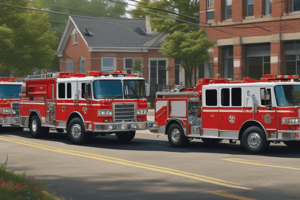Podcast
Questions and Answers
Which of the following is a best practice when drafting mutual aid agreements? (Select all that apply)
Which of the following is a best practice when drafting mutual aid agreements? (Select all that apply)
- A responder's license, certificate, or permit should be invalid in the requesting jurisdiction.
- The period of time covered by the agreement should be indefinite.
- Participating jurisdictions should have insurance or another form of protection in place. (correct)
- Agreements should prohibit future supplemental agreements between the parties to the agreement.
A month after your mutual aid agreement is activated for an incident, a participating jurisdiction claims that their responders are suffering from health problems and that it is your responsibility to pay for their care. Your first step in this situation should be:
A month after your mutual aid agreement is activated for an incident, a participating jurisdiction claims that their responders are suffering from health problems and that it is your responsibility to pay for their care. Your first step in this situation should be:
- Check the Insurance and Liability section of your mutual aid agreement. (correct)
- Tell them to file a claim with your insurance company.
- Reimburse them.
- Check the Demobilization section of your mutual aid operational plan.
The primary purpose of a mutual aid operational plan is to:
The primary purpose of a mutual aid operational plan is to:
- Ensure continuity of operations.
- Secure funding for needed resources.
- Provide detailed procedures for implementing a mutual aid agreement.
- Present an action plan in the case that a jurisdiction is unable to provide needed resources. (correct)
Which of the following phrases best describes the purpose of the National Incident Management System (NIMS)?
Which of the following phrases best describes the purpose of the National Incident Management System (NIMS)?
Which of the following statements is FALSE?
Which of the following statements is FALSE?
It is essential for the Incident Commander to monitor the status of resources throughout their assignment. If resource needs change, the Incident Commander's best course of action is to:
It is essential for the Incident Commander to monitor the status of resources throughout their assignment. If resource needs change, the Incident Commander's best course of action is to:
Which of the following is an example of intrastate mutual aid?
Which of the following is an example of intrastate mutual aid?
What type of assessment helps to determine if your jurisdiction can respond to or adequately deal with incidents identified in the hazard analysis?
What type of assessment helps to determine if your jurisdiction can respond to or adequately deal with incidents identified in the hazard analysis?
The 'Severability' section of a mutual aid agreement addresses:
The 'Severability' section of a mutual aid agreement addresses:
Which of the following is a best practice for updating your mutual aid agreement?
Which of the following is a best practice for updating your mutual aid agreement?
A mutual aid working group is responsible for the following tasks EXCEPT for:
A mutual aid working group is responsible for the following tasks EXCEPT for:
Which of the following statements about the 'Terms and Conditions' section of a mutual aid agreement is FALSE?
Which of the following statements about the 'Terms and Conditions' section of a mutual aid agreement is FALSE?
Mutual aid operational plans should include information about all of the following EXCEPT for:
Mutual aid operational plans should include information about all of the following EXCEPT for:
The 'References and Authorities' section of a mutual aid agreement includes details about:
The 'References and Authorities' section of a mutual aid agreement includes details about:
In which section is information about who can activate the mutual aid agreement typically found?
In which section is information about who can activate the mutual aid agreement typically found?
A participating jurisdiction has made a request for assistance that includes the following information:
A participating jurisdiction has made a request for assistance that includes the following information:
Homeland Security Presidential Directive 5 (HSPD-5) established the:
Homeland Security Presidential Directive 5 (HSPD-5) established the:
Which of the following statements is FALSE?
Which of the following statements is FALSE?
County A received equipment that was of a lesser capacity than requested from County B (their mutual aid partner). What best practice is desired to prevent this from occurring?
County A received equipment that was of a lesser capacity than requested from County B (their mutual aid partner). What best practice is desired to prevent this from occurring?
A mutual aid working group typically includes the following individuals:
A mutual aid working group typically includes the following individuals:
Flashcards
Mutual Aid Insurance
Mutual Aid Insurance
Insurance or protection to cover risks during aid
Mutual Aid Operational Plan Purpose
Mutual Aid Operational Plan Purpose
Outlines actions for support.
National Incident Management System (NIMS)
National Incident Management System (NIMS)
System that enables responders from different jurisdictions to work together effectively during incidents.
Mutual Aid Agreements
Mutual Aid Agreements
Signup and view all the flashcards
Capability Assessments
Capability Assessments
Signup and view all the flashcards
"Severability" Section
"Severability" Section
Signup and view all the flashcards
Mutual Aid Working Group Responsibilities
Mutual Aid Working Group Responsibilities
Signup and view all the flashcards
"References and Authorities" Section
"References and Authorities" Section
Signup and view all the flashcards
Activation Procedures Location
Activation Procedures Location
Signup and view all the flashcards
HSPD-5 Significance
HSPD-5 Significance
Signup and view all the flashcards
Resource Typing
Resource Typing
Signup and view all the flashcards
Legal Experts
Legal Experts
Signup and view all the flashcards
Study Notes
Mutual Aid Agreements Best Practices
- Participating jurisdictions should have insurance or protection mechanisms in place to cover risks during aid.
- Agreements should allow for flexibility and supplemental agreements, contrary to prohibiting them.
- An Incident Commander must monitor resources and reassign as necessary rather than create new plans.
Purpose of Mutual Aid Operational Plans
- The primary function is to outline actions for support when jurisdictions cannot provide required resources.
NIMS Overview
- The National Incident Management System (NIMS) is designed for responders from various jurisdictions to collaborate effectively in incident response.
Understanding Mutual Aid
- Mutual aid agreements enhance response resources and must be formalized in writing to avoid conflicts.
- Such agreements are not limited to only two participants, promoting broader cooperation.
Resource Management
- Incident Commanders may need to reassign resources based on changing requirements during operations.
- Capability assessments determine whether jurisdictions can handle incidents identified in hazard analysis.
Mutual Aid Agreement Validations
- The "Severability" section allows jurisdictions to withdraw while keeping the agreement intact for remaining participants.
- Best practices for updating agreements include consulting state or local emergency management for current data.
Responsibilities of Mutual Aid Working Groups
- These groups are responsible for maintaining documents and reviewing after-action reports but do not handle reimbursements.
Terms and Conditions in Agreements
- The section clarifies renewal processes and limits conditions under which assistance may be withheld but does not solely define the agreement's duration.
Mutual Aid Operational Plans Requirements
- Plans must outline requests for assistance, after-action reviews, and maintenance but do not need to address mitigation directly.
Legal and Regulatory Framework
- The "References and Authorities" section cites statutes or regulations that authorize mutual aid agreements, ensuring legal compliance.
Activation of Mutual Aid Agreements
- Activation procedures typically fall under the "Roles and Responsibilities" section of the mutual aid agreement.
HSPD-5 Significance
- Homeland Security Presidential Directive 5 established the National Incident Management System to unify federal incident response.
Resource Reassignment Policies
- Resources can be reallocated before mission completion, and mutual aid agreements allow withdrawal due to emergencies, while self-dispatch is discouraged.
Resource Typing
- To prevent mismatches in requested aid, best practices include implementing resource typing for accurate support allocation.
Composition of Mutual Aid Working Groups
- Typically includes legal experts to navigate agreements' compliance and responsibilities, ensuring clarity within inter-jurisdictional collaborations.
Studying That Suits You
Use AI to generate personalized quizzes and flashcards to suit your learning preferences.




